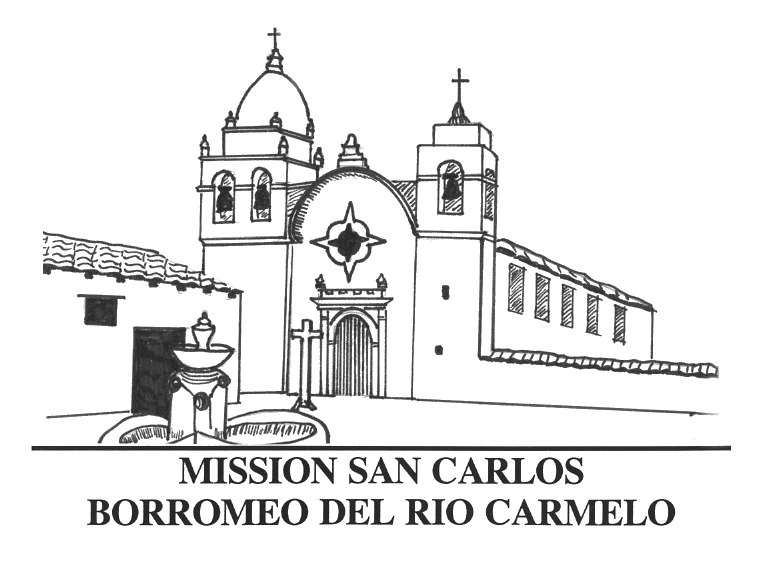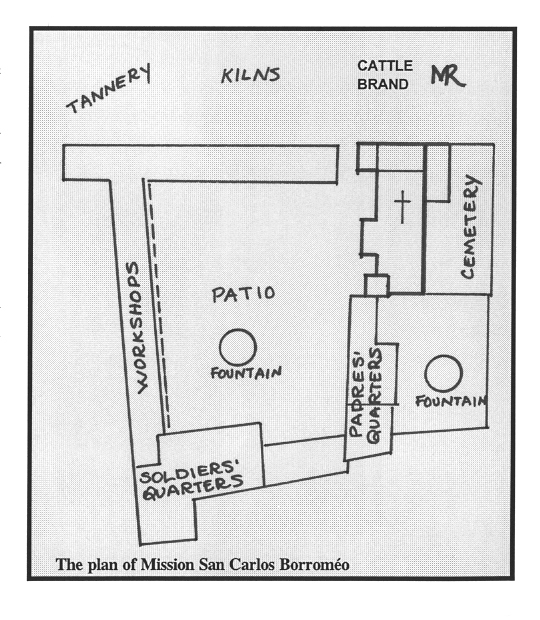| ||||
|
| ||||
|
MISSION
SAN CARLOS BORROMEO DEL RIO CARMELO
3080
Rio Road
Carmel, CA 93923
Established: June 3, 1770
By: Father Junípero Serra, Franciscan missionary, President of the missions.
Order: 2nd of the 21 missions.
Location: About 120 miles south of San Francisco at the mouth of the Carmel Valley, on a hillside a half mile from the sea.
Named: For St. Charles of Borroméo, a 16th-century cardinal and archbishop of Milan, Italy. Also known as Carmel Mission.
California Historical Landmark No. 135
DESIGN OF THE MISSION
Church:
150 feet long, 29 feet wide, 33 feet high. Made of native yellow sandstone
blocks from the nearby
Style: Designed by Manuel Ruíz, a master mason from Mexico City, who also designed the Royal Chapel in Monterey. He incorporated Moorish elements into the plan. The walls taper inward to form an arched ceiling. The restored wooden ceiling is painted to look like stone. A unique feature is the Moorish window, often called the "star window," over the entrance. It appears to be made from a combination of a circle and a square placed at an angle.
Walls: Five feet thick at the base, becoming wider as they go up, so that the walls curve inward. The windows are high up on the walls.
Bell Towers: The two bell towers, which differ in size and design, have held various numbers of bells (from 4 to 11). The larger is topped by a Moorish dome, with an outside staircase giving access to the belfry.
Mission Compound: The living quarters and workshops for the mission were built around a quadrangle, but unlike most of the missions, it is irregularly shaped. The front of the quadrangle is shorter than the back section. A fountain and gardens with olive trees add beauty to the compound. Carved in the stones of a wall of the courtyard are the coats of arms of the Orders of the Dominicans and the Franciscans, with statues of their founders, St. Dominic and St. Francis.
Mission Grounds: This mission did not have extensive agriculture or livestock herds. The Esselen Indians were fewer in number than native people living near other missions, so there was not as great a need for large-scale farming. A simple canal brought water from the Carmel River to the mission compound for irrigation.

EARLY HISTORY
1770 Father Serra and Governor Portolá arrived in Monterey Bay to establish a presidio (fort) and what was intended to be the northernmost mission. Under an ancient oak tree, they dedicated the mission. The presidio was built first and Father Serra held church services in a storeroom there.
1771 Wanting the church to be separated from the presidio, Serra selected a site five miles south. A church was built of pine and cypress logs, with a mud-covered thatch roof.
1774 An adobe church replaced the log church. Over the next decade the church was replaced several times with other adobe structures.
1784 Father Serra died on August 28 and was buried in the church. Father Palóu became President of the missions but soon was replaced by Father Lasuén.
1791 Manuel Ruíz was hired to design and build a stone church.
1793 Cornerstone laid for the church.
1797 Dedication of the new church was celebrated with a grand fiesta.
1803 Father Lesuén died; buried beside Father Serra in the church.
1814 Vaulted stone roof was replaced after earthquake damage.
1818 The pirate Hippolyte Bouchard of Argentina attacked the Monterey presidio, but didn't harm the mission.
1834 Mission secularized, the lands sold and the buildings abandoned.
1851 Roof beams had rotted and the roof fell in. Only a small chapel survived intact.
1859 Mission returned to the Catholic Church by the U.S. government.
1882 Father Angelo Casanova, pastor in Monterey, ordered the graves in the church opened, to quell rumors that Father Serra's body had been removed.
1884 Father Casanova raised money to repair the church in honor of the 100-year anniversary of Father Serra's death. A steep shingle roof was built over the church. Though it helped to preserve the building from further decay, it was not in style with the rest of the Mission.
CARMEL MISSION TODAY
True restoration of the mission began in the 1930's under the supervision of Harry Downie. One of the first things Downie did was to replace the shingle roof with an accurate replica of the original tile roof. His expertise has made this restoration complete and authentic, including replacement of the entire mission quadrangle based on excavations of the original foundations. In 1984 the original fountain, which had been held by a Carmel family for more than 100 years, was returned to its place.
Of special interest at the mission is the small cell where Father Serra lived, with its simple furnishing of a board bed, single blanket, table, chair, chest, candlestick, and gourd. The mission library (California's first library, once containing 1500 volumes) still has books that belonged to Father Serra. In a small chapel is the statue of the Virgin which Father Serra brought to the San Diego Mission and then on to Carmel. Many historical treasures of the church are on display here.
In 1933 Carmel Mission became the parish church. It was designated as a minor basilica in 1960 by Pope John XXIII, honoring its historical importance as the headquarters of the California mission chain, and received a visit from Pope John Paul II in 1987. A fiesta honoring St. Charles Borroméo is held each September.
